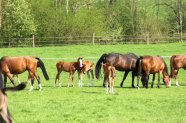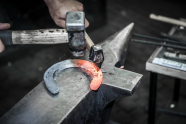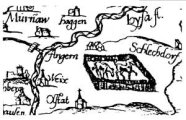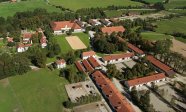
Teaching, Test and Technical Center for Equine Husbandry
principal and federal stud schwaiganger
About Schwaiganger
- The first recorded mention of Schwaiganger was in 955 AD.
- Horses have been kept here for more than 1000 years.
- Schwaiganger is one of the last four Main and State Stud Farms in Germany. Stud with own mare herd and offspring and stallion depot.
- The historical buildings date back to the time of Elector Max III and Duchess Maria Anna (1780-1790).
- Area: 850 ha, with 400 ha of grassland and 312 ha of forest.
- Location: 70 km south of Munich at an altitude of nearly 700 m above sealevel, at the foot of the mountain Heimgarten between the lakes Staffelsee, Kochelsee and Riegsee.
- About 250 horses: warmbloods, South German draught horses and Haflingers.
- Schwaiganger is also committed to the protection of endangered breeds of farm animal such as the sheep Steinschaf, Brillenschaf and Schwarzes Bergschaf, the Murnau-Werdenfels cattle and Rottaler horses.
- The teaching, research and demonstration center Schwaiganger is a center of excellence offering training and professional development courses on horse care and breeding and riding/driving; the state horse-shoeing or farrier school is also based here.
Horse breeding at the main and state stud farm
Stud farming (at the state stud farm) has to date been one of Schwaiganger's main functions. Located in the heart of Bavaria, which has a great horse breeding tradition. Schwaiganger provides stallions for breeding warmbloods (German Sporthorse), Haflingers and South German Draught Horse, by providing stallions for breeding. Breeders have access to the studs throughout the breeding season from February to July for covering or insemination.
Breed mares at the Main Stud Farm provide the next generation, and colts are also regularly purchased to increase the number of stallions available. Schwaiganger is committed to continuous improvements in the quality of the horses themselves, and also in their living conditions and care. Once foals have been weaned from the mother mare, they are separated by sex and spend the next two to three years in the pasture in their groups. The next generation of potential stallions are picked for licensing when they turn two-and-a-half.
Education and research
The teaching, research and demonstration center for equine husbandry Schwaiganger is Bavaria's center of excellence for horse breeding and care. The Bavarian State Research Center for Agriculture (LfL) is the service and expertise center for the agricultural sector in Bavaria. It is a state authority under the direct control of the Bavarian State Ministry of Food, Agriculture and Forestry with responsibilities in research, testing, regulation, funding and training and professional development. The Teaching, research and demonstration center for equine husbandry works closely with the relevant institutes at the State Research Center for Agriculture to run tests, in particular in the fields of horse breeding, feeding, ethology and care. Around 35 people are currently employed on the stud farm, and there are also eight trainee posts.
The State farrier School has been established at Schwaiganger in 1955. In Germany, the official term for blacksmith is "Hufbeschlagschmied /in", and means a specialist in hoof care and shoeing. A blacksmith or farrier traditionally produces the horseshoes and horseshoe nails himself or herself and adapts each shoe to the shape of the hoof. A blacksmith's work also includes treating injured and diseased hooves. In the light of the immense importance of shoeing to the protection and health of hoofed animals, state accreditation is a statutory requirement for all those working in the profession.
History
Schwaiganger can trace its history back 1000 years. The name is a compound of Schwaige = "farmstead" and Anger = "pasture/meadow". In 955 AD, we find the first recorded mention of the "Schwaige", at that point owned by a Hungarian.
The Schwaige changed owner frequently right up until the end of the 15th century. Not until the 16th century, after the farm was taken over by the House of Wittelsbach, was there reasonable continuity. The very first map of Bavaria from around 1550 shows a horse farm below the name Angern, which indicates the importance of Schwaiganger for horse breeding even back then. From 1780 to 1790, Schwaiganger was the manor of Duchess Maria Anna of Bavaria, the widow of Duke Clemens Franz de Paula.
The Schwaige changed owner frequently right up until the end of the 15th century. Not until the 16th century, after the farm was taken over by the House of Wittelsbach, was there reasonable continuity. The very first map of Bavaria from around 1550 shows a horse farm below the name Angern, which indicates the importance of Schwaiganger for horse breeding even back then. From 1780 to 1790, Schwaiganger was the manor of Duchess Maria Anna of Bavaria, the widow of Duke Clemens Franz de Paula.
Schwaiganger - the manor of Duchess Maria Anna of Bavaria
One surviving item from this era is the sundial on the main building, the top section of which shows Duchess Maria Anna of Bavaria.
The Bavarian State took over Schwaiganger stud farm in 1930 and set up a cold bloods stud farm. In 1980, the Landshut State Stud Farm closed and the Bavarian Main and State Stud Farm was established at Schwaiganger. Since 2004, Schwaiganger has been the teaching, research and demonstration center for equine husbandry of the Bavarian State Research Center for Agriculture (LfL).
Since 2020 Schwaiganger has been part of the Bavarian State Property (in german: "Bayerische Staatsgüter") as the Educational Center for Horsekeeping and Horseback Riding.
The Bavarian State took over Schwaiganger stud farm in 1930 and set up a cold bloods stud farm. In 1980, the Landshut State Stud Farm closed and the Bavarian Main and State Stud Farm was established at Schwaiganger. Since 2004, Schwaiganger has been the teaching, research and demonstration center for equine husbandry of the Bavarian State Research Center for Agriculture (LfL).
Since 2020 Schwaiganger has been part of the Bavarian State Property (in german: "Bayerische Staatsgüter") as the Educational Center for Horsekeeping and Horseback Riding.









